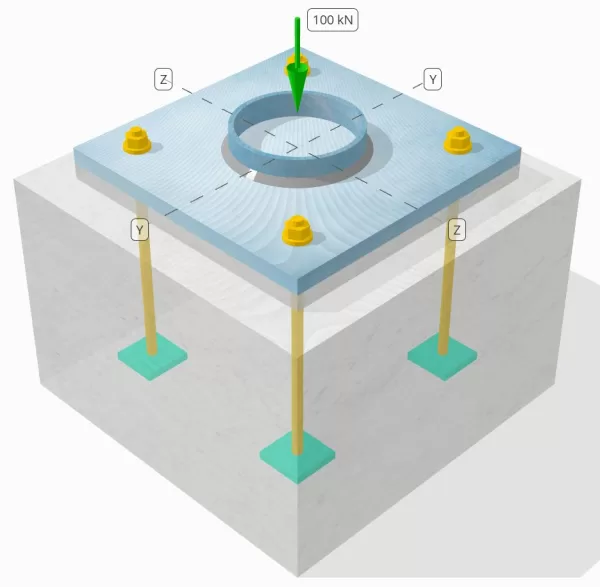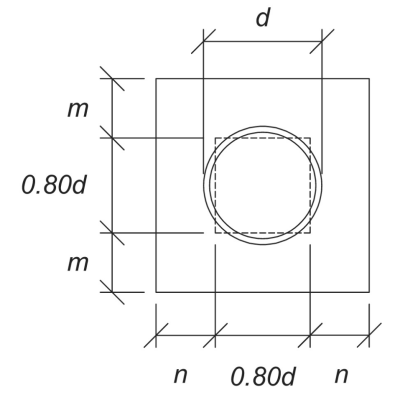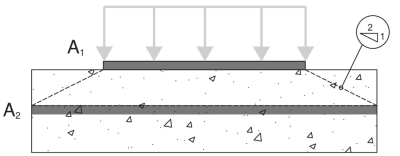使用CSA S16的底板设计示例:19 和CSA A23.3:19

问题陈述
确定设计的列板连接是否足以容纳100 kn压缩负荷.
给定数据
柱:
列部分: HS152X6.4
列区域: 2910 毫米2
列材料: 230G
底盘:
基板尺寸: 350 毫米× 350 毫米
基板厚度: 20 毫米
底板材料: 230G
灌浆:
灌浆厚度: 20 毫米
具体:
混凝土尺寸: 450 毫米× 450 毫米
混凝土厚度: 300 毫米
混凝土材料: 20.68 兆帕
焊缝:
仅通过焊缝传输的压缩负荷? 不
SkyCiv 免费工具中的模型
立即使用我们的免费在线工具对上面的底板设计进行建模! 无需注册.
分步计算
检查一下 #1: 计算柱的轴承能力
由于压缩负荷不是单独通过焊接传递的, 需要适当的接触轴承表面以确保负载通过轴承转移. 参考 CSA S16:19 条款 28.5 用于接触轴承准备.
计算列的轴承能力, 我们将使用 CSA S16:19 条款 13.10:
\( b_r = 1.50 \phi f_{和 _COL} 一个_{上校} = 1.5 \次 0.9 \次 230 \, \文本{兆帕} \次 2910 \, \文本{毫米}可以假设为 903.55 \, \文本{千牛} \)
以来 100 千牛 < 903.55 千牛, 柱轴承能力为 充足的.
检查一下 #2: 计算焊接容量
用 最小焊接尺寸 指定在 CSA S16:19.
检查一下 #3: 计算由于压缩负荷而导致的底板弯曲屈服能力
底板的弯曲能力取决于其尺寸. 如果盘子太宽, 它需要更厚的材料. 为给定的负载选择正确的基板尺寸需要经验, 进行多次计算可能是耗时的. 的 SkyCiv底板设计软件 简化了此过程, 仅在几秒钟内实现快速有效的建模和分析.
第一, 我们确定关键的悬臂长度, 更大的 尺寸米 和 维度n. 我们跟随 AISC 设计指南 01 3Rd Ed. 部分 4.3.1 作为参考.
\( l = max 左( \压裂{L_{BP} – 0.8 d_{上校}}{2}, \压裂{b_{BP} – 0.8 d_{上校}}{2} \对) \)
\( l = max 左( \压裂{350 \, \文本{毫米} – 0.8 \次 152 \, \文本{毫米}}{2}, \压裂{350 \, \文本{毫米} – 0.8 \次 152 \, \文本{毫米}}{2} \对) = 114.2 \, \文本{毫米} \)
一旦确定了临界长度, 我们计算 每单位长度施加力矩, 假设全部压缩负荷均匀分布在基板区域:
\( m_f = left( \压裂{n_x}{b_{BP} L_{BP}} \对) \剩下( \压裂{l^2}{2} \对) \)
\( m_f = left( \压裂{100 \, \文本{千牛}}{350 \, \文本{毫米} \次 350 \, \文本{毫米}} \对) \时代左( \压裂{114.2 \, \文本{毫米}^ 2}{2} \对) = 5.3231 \, \文本{千牛} \CDOT text{mm/mm} \)
现在, 使用 CSA S16:19 条款 13.5, 我们计算单位长度的弯曲能力:
\(
m_r = phi 左( \压裂{(t_{BP})^ 2}{4} \对) F_{和 _bp} = 0.9 \时代左( \压裂{(20 \, \文本{毫米})^ 2}{4} \对) \次 230 \, \文本{兆帕} = 20.7 \, \文本{千牛} \CDOT text{mm/mm}
\)
以来 5.3231 kn-mm/mm < 20.7 kn-mm/mm, 基板弯曲能力为 充足的.
检查一下 #4: 混凝土轴承能力
最终检查确保混凝土可以支持施加的负载. 而更宽的混凝土基础增加了轴承能力, 有效的设计必须平衡力量和成本效益. 现在, 让我们确定我们的具体支持是否具有足够的能力.
开始, 我们确定轴承区域:
A1 - 底板轴承区域
A2 - 混凝土支撑轴承区, 预测在 2:1 坡
\(
a_1 = l_{BP} b_{BP} = 350 \, \文本{毫米} \次 350 \, \文本{毫米} = 122500 \, \文本{毫米}^ 2
\)
\(
a_2 = n_{A2} b_{A2} = 450 \, \文本{毫米} \次 450 \, \文本{毫米} = 202500 \, \文本{毫米}^ 2
\)
从那里, 我们申请 CSA A23.3:19 计算混凝土轴承能力:
\(
p_r = 0.85 \phi 左( f’_c 对) A_1 左( \最小左( \sqrt{\压裂{A2}{A_1}}, 2 \对) \对)
\)
\(
p_r = 0.85 \次 0.65 \时代左( 20.68 \, \文本{兆帕} \对) \次 122500 \, \文本{毫米}^2 times 左( \最小左( \sqrt{\压裂{202500 \, \文本{毫米}^ 2}{122500 \, \文本{毫米}^ 2}}, 2 \对) \对) = 1799.5 \, \文本{千牛}
\)
以来 100 千牛 < 1799.5 千牛, 混凝土轴承能力是 充足的.
设计概要
SkyCiv基板设计软件可以自动生成此设计示例的分步计算报告. 它还提供了执行的检查及其结果比率的摘要, 一目了然地使信息易于理解. 以下是示例摘要表, 报告中包括.

SkyCiv样本报告
查看 SkyCiv 底板设计报告的详细程度和清晰度. 该报告包括所有关键的设计检查, 方程式, 并以清晰易读的格式呈现结果. 完全符合设计标准. 单击下面查看使用 SkyCiv 底板计算器生成的示例报告.
购买基板软件
单独购买基本板设计模块的完整版本,而没有任何其他SkyCiv模块. 这为您提供了底板设计的完整结果, 包括详细报告和更多功能.




